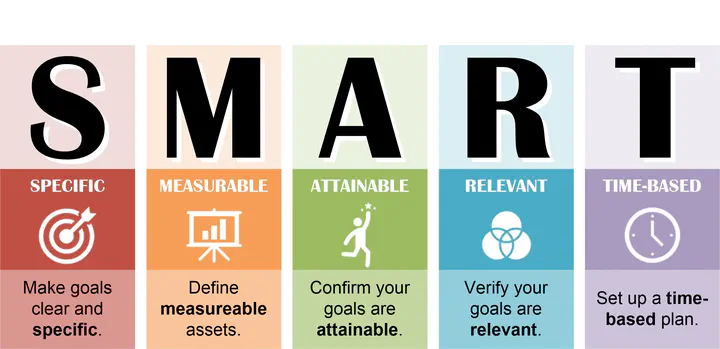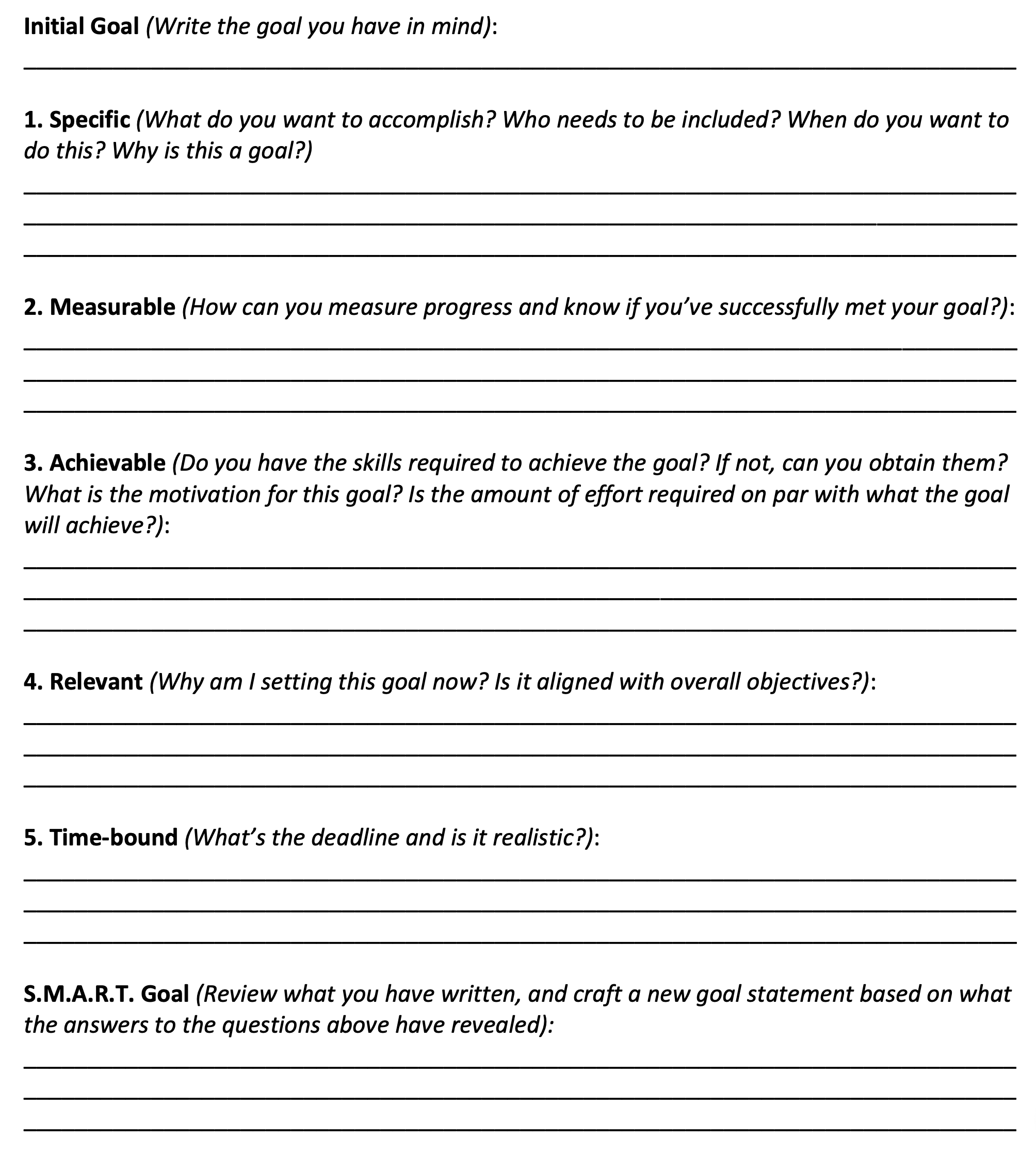SMART Goals

Table of Contents
What Are SMART Goals?
SMART is an acronym that you can use to guide your goal setting. SMART stands for Specific, Measurable, Achievable, Relevant, and Time-Bound.
SMART Criteria
SMART Criteria
| Criteria | |
|---|---|
| Specific | What will you achieve? What will you do? |
| Measurable | What data will you use to decide whether you’ve met the goal? |
| Achievable | Is the goal doable? Do you have the right skills and resources? |
| Relevant | How does the goal align with broader goals? Why is the result important? |
| Time-bound | What is the deadline for accomplishing the goal? |
How to Decide the Right Scope of SMART Goals?
Remember, goals are intended to focus attention and resources on what is most important so that you can be successful in achieving your priorities.
Common types of goals are to:
Increase something
Make something
Improve something
Reduce something
Save something
Develop someone (yourself!)
Where to Start?
Start by thinking about your whole job and the broad areas (or “buckets”) of responsibility and results for which you are accountable.
Develop a goal statement for each bucket. To get the scope right, remember to focus on end results not tasks.
Goals should be high level enough to encompass the core outcomes for which you are responsible, but specific and clear enough so you will be able to measure success.
Goals should be on-going job responsibilities and any new projects, assignments, priorities, or initiatives that are specific to this performance cycle.
Having too many goals can be an indicator that your goals are scoped at too low a level and are focused more on tasks than on end results!
- If it seems that your goals are becoming too numerous and task-oriented, it may be helpful to consider combining several goal statements into a broader outcome area.
How to Wrtie a SMART Goal?
Specific
When setting a goal, be specific about what you want to accomplish. Think about this as the mission statement for your goal, instead of a detailed list of how you’re going to meet a goal.
When drafting your goal, try to answer the “W” questions:
Who
Consider who needs to be involved to achieve the goal (this is especially important when you’re working on a group project).
What
Think about exactly what you are trying to accomplish and don’t be afraid to get very detailed.
When
You’ll get more specific about this question under the “Time-bound” section of defining SMART goals, but you should at least set a time frame.
Where
This question may not always apply, especially if you’re setting personal goals, but if there’s a location or relevant event, identify it here.
Which
Determine any related obstacles or requirements. This question can be beneficial in deciding if your goal is realistic.
Why
What is the reason for the goal?
Measureable
It’s important to have measurable goals, so that you can track your progress and stay motivated. Assessing progress helps you to stay focused, meet your deadlines, and feel the excitement of getting closer to achieving your goal.
If it’s a project that’s going to take a few months to complete, then set some milestones by considering specific tasks to accomplish. (Milestones are a series of steps along the way that when added up will result in the completion of your main goal.)
- There should be a source of information to measure or determine whether a goal has been achieved, i.e., a direct (or possibly indirect) indicator of what success for a particular goal will look like.
- Sometimes measurement is difficult, you may need to identify the most relevant and feasible data sources and collection methods.
- Data collection efforts needed to measure a goal can be included in that goal’s action plan.
- Even if a perfect, direct measurement source is not immediately feasible for a given goal, the discussion about the desired end result (why this goal is important) and what the measurement options are (what success might look like) is an important and valuable part of performance planning.
- Measurement methods can be both quantitative (productivity results, money saved or earned, etc.) and qualitative (client testimonials, surveys, etc.).
Typical data types and data collection methods:

Achievable
Your goal also needs to be realistic and attainable to be successful. In other words, it should stretch your abilities but still remain possible. The goal is meant to inspire motivation, not discouragement. Think about:
- how to accomplish the goal,
- if you have the tools/skills needed,
- if not, consider what it would take to attain them.
Relevant
This step is about ensuring that your goal matters to you, and that it also aligns with other relevant goals. Make sure that your plans drive everyone forward, but that you’re still responsible for achieving your own goal.
A relevant goal can answer “yes” to these questions:
- Does this seem worthwhile?
- Is this the right time?
- Does this match our other efforts/needs?
- Am I the right person to reach this goal?
- Is it applicable in the current socio-economic environment?
Time-bound
Every goal needs a target date, so that you have a deadline to focus on and something to work toward. It helps to prevent everyday tasks from taking priority over your longer-term goals. If the goal will take a relative long time to complete, it’s useful to define what should be achieved half-way through the process.
A time-bound goal will usually answer these questions:
- When?
- What can I do six months from now?
- What can I do six weeks from now?
- What can I do today?
Examples of Creating a SMART Goal
Completing a project
Goal:“I want to complete a project.”
Specific
Many people are accessing our current site from their mobile devices. Since it’s not a responsive site, it provides a poor experience for customers (“why”). I want to launch a mobile app for my company website (“what”) by the end of June (“when”), which requires involvement from software development, design, and marketing (“who”).
Measurable
Creating a mobile app for our company site will require a lot of resources. To make it worthwhile, I’d like to have 50,000 installs of the site within six months of launch. I’d also like to show a 5% conversion rate from customers using the mobile site.
Achievable
The departments that will be involved have signed-off on creating a mobile app. I’ll need to manage the project and set milestones to keep everyone motivated and on target.
Relevant
Improving the customer experience on mobile devices is a core initiative for my company this year.
Time-bound
In order to achieve 50,000 mobile app installs and a 5% conversion rate by the end of the fiscal year, the app will need to be launched by Q2 with a robust marketing campaign that should continue through the end of the year.
Combine S.M.A.R.T characteristics into one S.M.A.R.T goal:
Description
Improving the customer experience on mobile devices is a core initiative for my company this year, so we are going to create a mobile app. By the end of the fiscal year, there should be 50,000 installs of the mobile app we develop, and it should produce a 5% conversion rate. We’ll build the mobile app in-house and launch it by the end of June with an app-related marketing campaign that will continue to the end of the year.
Milestone Mobile app launches end of June.
Deadline
End of the fiscal year.
Improving personal performance
Goal: “I want to improve my performance”
Specific
I received low marks on my ability to use PowerPoint at my last performance review. Improving my skills requires that I learn how to use PowerPoint efficiently and practice using it by creating various presentations. I’d like to be more proficient using PowerPoint in time for my next review in six months.
Measurable
By the time of my next review, I should be able to create presentations that incorporate graphs, images, and other media in a couple of hours. I should also be able to efficiently use and create templates in PowerPoint that my coworkers can also use.
Achievable
Improving my PowerPoint skills is instrumental in moving forward in my career and receiving a better performance review. I can set time aside every week to watch PowerPoint tutorials and even enroll in an online class that can teach me new skills. I can also ask coworkers and my manager for PowerPoint tips.
Relevant
Working with PowerPoint is currently 25% of my job. As I move up in the company, I’ll need to spend 50% of my time creating PowerPoint presentations. I enjoy my career and want to continue to grow within this company.
Time-bound
In six months, I should be proficient in PowerPoint ensuring it only occupies 25% of my workload instead of the nearly 40% of the time it occupies now.
Combine S.M.A.R.T characteristics into one S.M.A.R.T goal:
Description
To grow in my career, I need to improve my PowerPoint skills. By taking online classes and reviewing tutorials, I’ll improve my PowerPoint skills so that it only requires 25% of my work time.
Milestone Complete an online PowerPoint course in three months.
Deadline
Next employee review in six months.
Template for Writing a SMART Goal
